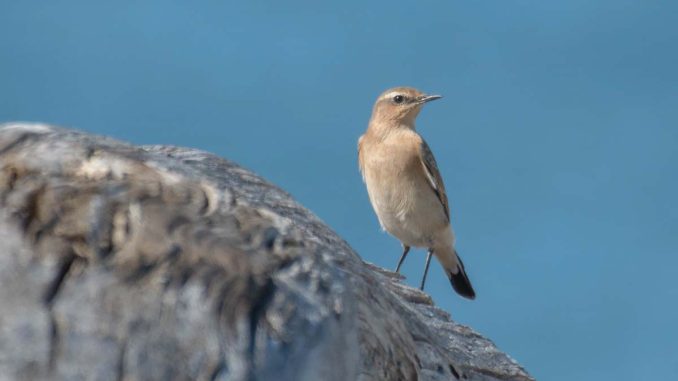
A local birder spotted a northern wheatear Sunday, Oct. 6, on Truman’s Beach in East Marion. Birders have since traveled to the North Fork from as far as California hoping to check it off their bird lists.
Jay Rand of Southold — a self-proclaimed bird and bug nerd of 27 years — went birding in the Narrow River Road area that morning. Not quite ready to hang up his binoculars for the day, on his way home he said he stopped at Truman’s Beach, where he hadn’t birded in a while.
He said he saw some royal terns right away and took them as a good sign. “Within 10 minutes, I heard a bird I hadn’t before,” Mr. Rand said. He described it as sounding similar to a horned lark or an American pipet doing a different call than he was used to.
Mr. Rand first spotted the bird while walking high on the beach, on a path between ground-covering bushes and stacked driftwood piles. “The bird popped up, very close. I didn’t need binos to ID it. I knew what it was. I fired off a few shots [with my camera] and then lost it.”
Not trusting himself due to the excitement of seeing the 5- to 6-inch bird he’d been hoping to spot for the last few years, Mr. Rand confirmed the identification using the Sibley Bird app and alerted other local birders, including Ben Bolduc, and together, they reported the sighting to the Cornell Lab of Ornithology ebird project and other birding groups in Whatsapp and other platforms.
Peggy Lauber, president of North Fork Audubon Society, confirmed via text that she, too, recently saw the rare bird at Truman’s Beach.
According to the National Audubon Society website, “birds from eastern Canada migrate east via Greenland and Europe, to winter in Africa. Birds from Alaska and northwestern Canada cross the Bering Strait and make long westward flight across Asia, also going to wintering grounds mostly in Africa.”
Mr. Rand said the last report of a northern wheatear on Long Island was “a handful of years ago,” and that when spotted in the region, they are usually found in western Suffolk, not on the East End. “It was probably a first year bird,” he said. “Immature birds are the ones that tend to migrate the wrong way.”
Although it was not where it should be, Mr. Rand said he and fellow birders observed it, learning some of its habits, and concluded it was not in distress.
“We watched it, enjoyed it. A couple other local guys showed up and it was so exciting and nerve wracking to share with friends,” Mr. Rand said.
“It was walking amongst the vegetation and catching and eating crickets. It bobs its tail as it walks,” he described. “It gives off a spunky, hyper personality. It beats the cricket to knock off the legs and then eats it.”
At press time there were 53 reported ebird observations of the northern wheatear at Truman’s Beach, the last one occurring on Saturday, Oct. 12. It was reported seen in the cedar stand across the salt marsh, its beach fun thwarted by strong winds when it took flight.
“I checked out some of the reports, and there was one birder from West Nyack, two from Maine and the kid that flew from California is originally from Kentucky, but was birding in California [doing a big year],” Mr. Rand updated via email.

